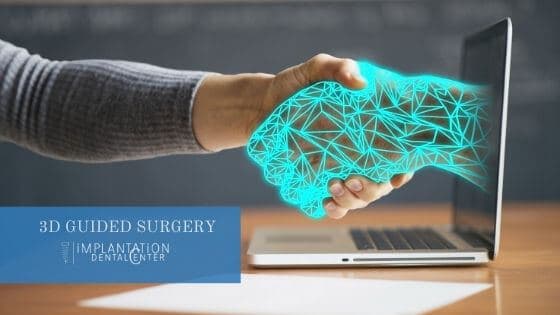Dental implants have become the most common and effective way to replace a missing teeth. Typically, implants are made out of titanium and are fused and integrated into the jawbone. Because of this, the spcecialist performing the implant surgery has to be precise and careful to ensure that the implants look natural and do not cause further damage or leave the gums vulnerable to disease.
Dental implant surgery, like any other surgery, can have a painful recovery period. Because of this, dental professionals aim to place the implants as accurately as possible to reduce damage to the gums, unnecessary bleeding, and pain. It can be challenging to place the dental implants accurately, though. Even the best practitioners are prone to making mistakes. This is why new and advanced oral surgery techniques are developed to improve processes and accuracy.
3D guided surgery provides a more accurate and predictable method to place dental implants. This cutting-edge technique involves taking 3-D x-rays of the mouth to help the specialist visualize the existing bone. Then, those images are placed on top of the impressions taken of the patient’s mouth. Advanced medical software is used to virtually place the implants in the patient’s mouth.
Following the positioning, the surgeon using a surgical guide to place the implants without sutures or an incision. This way, there is less post-operative pain and discomfort. With a quicker healing time, patients don’t have to worry about planning their oral surgery around their life.
Shortened recovery times improve the patient’s likelihood of seeking out dental implants. Dental implants are crucial to ensuring the bacteria don’t linger in spaces where there are missing teeth. This bacteria can cause gum disease, which leads to further complications and infections in the body. With an easier surgery and recovery time, dental implants are more accessible to those who are generally reluctant to have surgery or do not have the time.
3D surgery improves the accuracy and effectiveness of the surgery significantly. The improvement in accuracy significantly reduces the risk of mistakes and eliminates human error. Accurate placement of the dental implants reducing harm to the patient and ensures a better final result. A smoother surgery eliminates excessive bleeding and pain after the implantation.
The 3D surgical models and guides allow the doctor to practice placing the implant as many times as necessary before surgery. It is crucial to make sure that the implants, when performed during the real surgery, are positioned properly. This innovative technology allows dental professionals to ensure that they are prepared for the surgery.
Experts do not recommend dental implant surgery for everyone, though. They claim that the best candidates for the surgery have excellent oral health and do not have periodontal or gum disease. The better the health of the patient, the stronger the jaw and the healthier the gums. This helps for better and more effective placement of the implants.
If you’re interested in learning more about dental implants, contact our office today. We can schedule a consultation to walk you through the best options for your particular situation.




Pingback: I feel the screw in my dental implant, what should I do? Why is this happening?